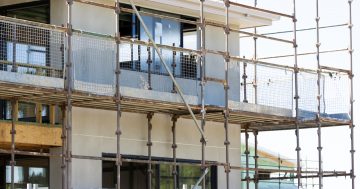
The Government wants dodgy builders gone from the industry. File photo.
The ACT Government has responded to continuing complaints about building defects, particularly in the booming apartment sector, with a new testing regime designed to weed dodgy builders out of the industry.
Under changes to the licensing of builders, starting from next year, up to 20 percent of all builders seeking to renew their licences will need to pass a test to ensure their skills and technical knowledge are up to scratch.
The Government says up to 180 builders will be tested annually from 2019, with a particular focus on those who have been subject to substantiated complaints or come to the attention of Access Canberra for building quality concerns. Those who fail after two attempts will not have licences renewed.
Those applying for class A, B and C licences for the first time in the ACT will need to sit a test, and the Constructions Occupations Registrar will be able to test any builders’ skills where the Registrar believes there are grounds for occupational discipline.
The Minister for Regulatory Services, Gordon Ramsay, said the tests would send a clear message to the industry that the Government will stop people trying to be builders without the required skills as a well as ridding the industry of underperformers.
He said the Government would also be strengthening the certification process by increasing the level of information builders need to provide to certifiers before work is signed off. Further announcements about this would be made in the coming months.
Over the next 18 months, other changes would include documentation guidelines for people preparing building approval applications for complex buildings, including apartment buildings; new training courses on the ACT’s building regulatory system and building approvals; codes of practice for builders and building certifiers; and development of a new auditing system from building approvals and building projects.
“Our message to industry is clear: You are on notice to lift building quality,” Mr Ramsay said.
“It is important that we work to address issues in quality at the source, by weeding out those in the industry who are not delivering to a standard we expect, rather than just managing the end result – which can be works that do not meet standards.”
Access Canberra will work with industry on the changes to licensing renewals and applications this year.
Master Builders ACT welcomed the announcement as a step in the right direction but says there are many more building reforms that are needed before the ACT has a best practice building regulatory system.
CEO Michael Hopkins said the expansion of the builder’s licence exam for Class C licenses, to Class A and B licence holders was but one of 43 recommended measures announced by Planning and Land Management Minister Mick Gentleman in 2016.
“The new exam will ensure licensees who have a poor compliance record, or have been inactive for a period of time, meet the same quality standards as the majority of quality ACT builders,” Mr Hopkins said.
“The MBA wants to see building quality in the ACT improve and it requires a co-operative effort from industry and Government in order to protect consumers,” Mr Hopkins said.
The construction industry in the ACT was dominated by small local businesses, who were finding it difficult to compete with operators who did not share the same values about quality work as the majority.
Owners Corporation Network President Gary Petherbridge said the licensing move was a small piece of positive news but the Government needed to act on other measures.
He said there was a lack of compliance by developers and policing by Access Canberra, and the original architects and engineers needed to be held to account, not just the builders.
Mr Petherbridge said the industry needed independent, preferably Government, certifiers to ensure work was up to standard, and licensing expanded to cover trades such as waterproofers, tilers and renderers.
Dodgy developers and builders needed to be named and shamed so consumers had a better guide from whom they were buying, and prevented from operating under a different name or ‘phoenixing’ their operations, he said.
Mr Petherbridge said the flexibility allowed to developers was “a word for do what you like and the community will put up with it, but the community is not going to put up with it forever.’’
Mr Ramsay said that in 2016, a written test at application for the C class licences in the ACT was introduced and of the 80 applicants, 38 failed the first attempt (48 per cent), with 17 (44 per cent) failing a second time.
“The testing has been an important measure we introduced to prevent those who do not have the knowledge or technical understanding we expect in the ACT, from working here. I’m pleased it is being extended to the other classes on application, as well as renewal,” Mr Ramsay said.
“In addition to the inherent safety risks that substandard building can cause, it also has significant financial and emotional impact on those in our community who are affected,” he said.
“These regulatory changes support the raft of improvements already under way and strike the right balance between supporting a high performing industry sector, as well as sending a clear signal that the ACT is open for business, growth and development – but to a high standard.”
The Government has already implemented 13 of the reforms and partially implemented one other of the Improving the ACT Building Regulatory System reforms announced in 2016.
These reforms include:
- further restrictions on the qualifications and experience required to gain an ACT licence;
- new provisions and powers to help prevent phoenixing in ACT construction licensees or people shifting their operations between existing licences;
- clarifying the roles of building certifiers and the obligations of corporate and partnership licensees in legislation;
- new grounds for occupational discipline and automatic suspensions; and
- expanding statutory warranties to all residential buildings.



















